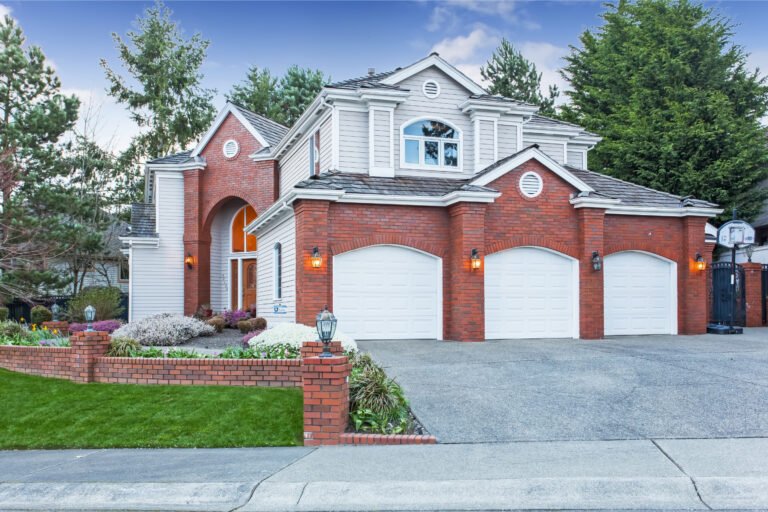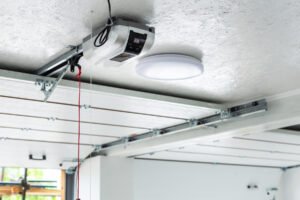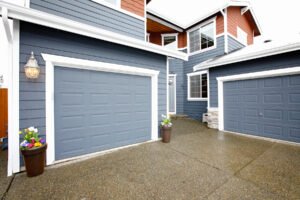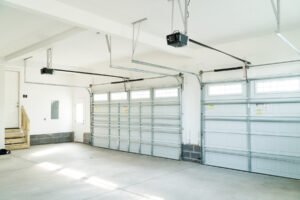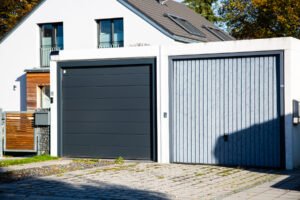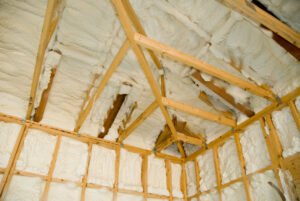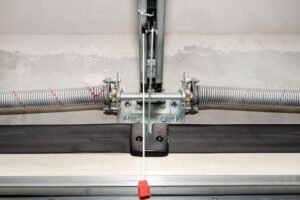Garage doors are a one-stop solution for security, convenience, and curb appeal. But, since they comprise about 30% of the visual mass, they can make or break your home’s overall exterior design. That’s why finding the right garage door, considering different mechanisms and materials is daunting for many homeowners!
So, in this detailed guide, we will analyze the designs, decor, materials, and accessibility of various types of garage doors and compare them to help you pick the best one for your home! With some helpful tips and FAQs, it’s going to be effortless!
Types of Garage Doors Based On Mechanism
Garage doors are multifunctional and come with different mechanisms, from manual operations to full automation, that enhance user comfort and driveway widths in their own way.
So, let’s explore the various opening mechanisms of each and pick the best one for your garage size.
1. Sectional Garage Doors
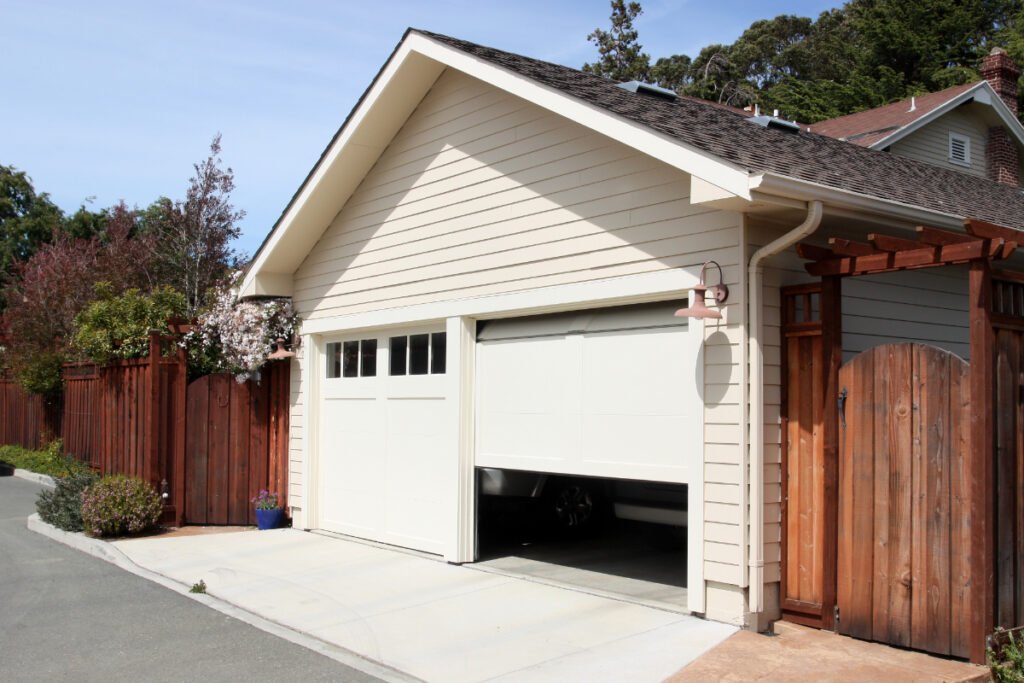
What Is It: A Sectional garage door is a horizontal-paneled, side-hinged door that fold along a vertical track. These doors have high tension extension springs and safety cables that operate the door easily and prevent it from falling when partially open.
Sectional doors fold into panels vertically; hence, they do not block any space in front of the garage driveway and allow a full-opening drive-through width. Moreover, they can be custom-made to fit any door opening and put less pressure on the garage door opener.
Plus, you can style a sectional garage door with large, ribbed panels for a modern look, or you can use traditional Georgian boards for a vintage ambiance.
Overall, sectional garage doors are great for single-car and 2-car garages and come with pre-installed rubber seals that add natural insulation to the garage door.
| Average Cost | $750 – 2500 |
| Average Lifespan | 15 – 20 years |
| Prominent Materials | Wood, High-grade Aluminum, or Steel |
| Average Weight | 130 – 150 lbs |
Pros:
- Visually appealing and comes in a range of finishes and colors
- Allow a clear driveway and Don’t take up space
- Operate smoothly and are Noise-free
- Are compatible with an automatic garage door opener and do not malfunction
Cons:
- Use horizontal tracks that take up some space on the garage ceiling
- Have a lot of parts that are tricky for DIY installation
- Need regular maintenance and oiling
- Are slightly expensive
A sectional door is prone to increased friction and noisy operations overtime. Hence lubricate it using white lithium grease or spray a penetrating solution for a smoother door opening.
2. Roller Doors
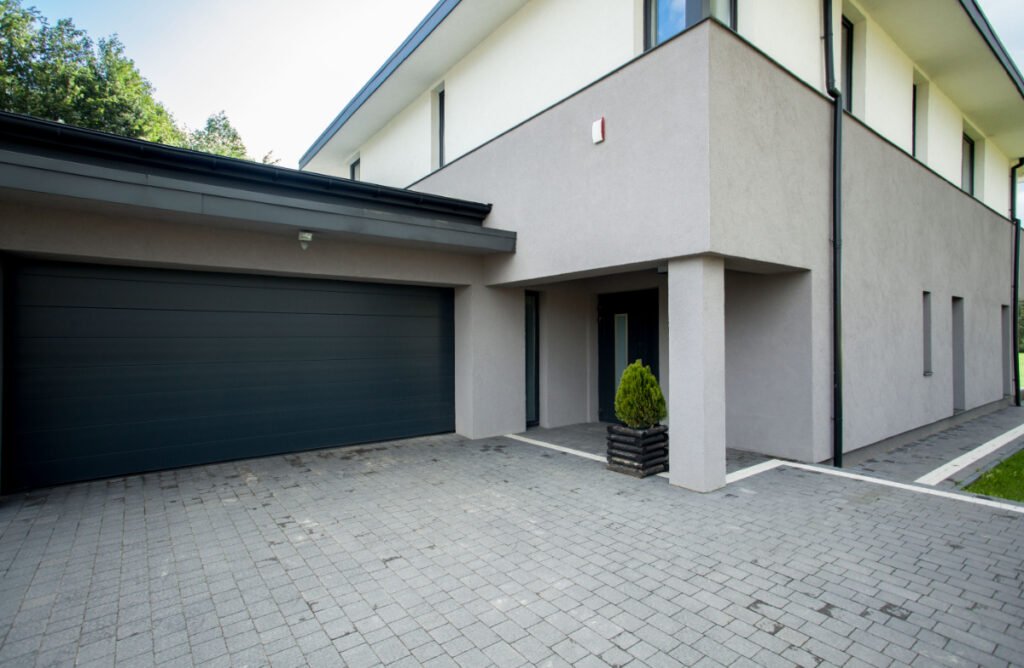
What Is It: A roller door or overhead door has slats and grooves that coil around a rotating drum, allowing the shutter to curve and bend right above the door.
Roller doors are high-grade, weather-resistant doors for larger residential and commercial garages and allow a space-saving design with automatically or electrically operated shutters. Moreover, these allow a clear driveway and can be installed without springs to save costs.
These are pretty thick and reduce the daily wear and tear to a greater extent, but they have high upfront costs that might look expensive for a one-time investment. Nevertheless, these doors are the right choice for smaller and wider garages and last a lifetime without much maintenance.
| Average Cost | $850 – 3000 |
| Average Lifespan | 25 – 35 years |
| Prominent Materials | Wood, Steel, Fiberglass or Vinyl |
| Average Weight | 160 – 250 lbs |
Pros:
- Provide greater security with lesser malfunctioning
- Durable and Weather-resistant
- Are Certified for Wind-load tests and do not bend
- Can hold the thicker foam, steel, or glass batt insulation
Cons:
- Require a professional garage door installation
- Expensive and Heavy
- Difficult to Paint and Polish after installation
Dust down all the leaves, twigs or any organic waste from your roller garage door tracks as these might absorb moisture and cause the door to rust and weather.
3. Slide-to-Side Doors
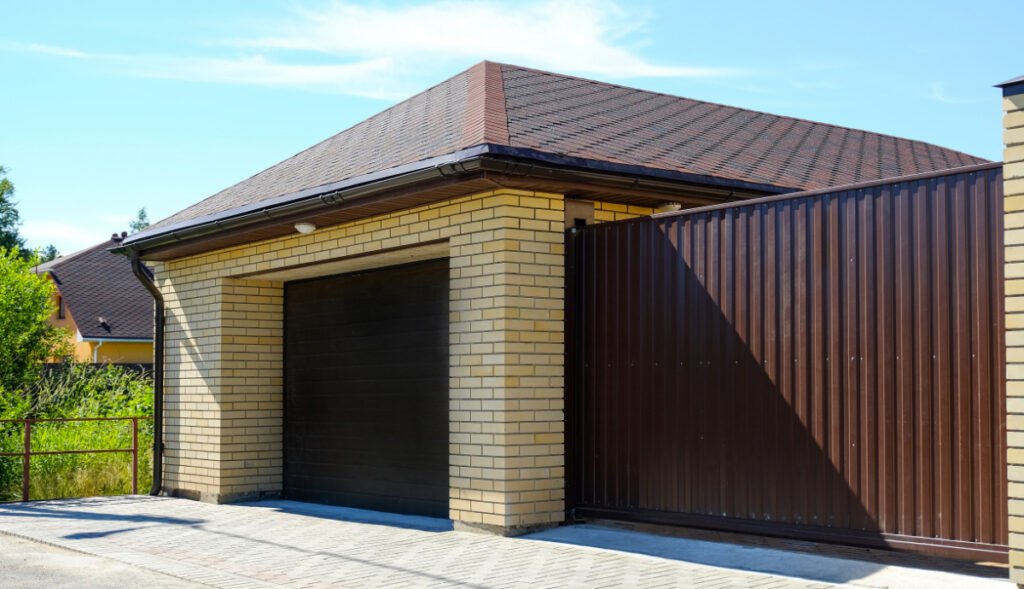
What Is It: Slide-to-side doors have side hinges and horizontal sliding tracks that push the door against the side of the garage wall when you open it and allow you to partially open or close the door as you please.
Slide-to-side doors have multiple hinged panels that allow you to move or rotate the shutters conveniently, thus allowing a clear attic and more space for garage workshops.
These run along lower trolleys and can be fitted with a retractable motor for automated operations. Plus, these are lightweight and do not require any garage door springs for balance.
| Average Cost | $700 – 1500 |
| Average Lifespan | 10 – 15 years |
| Prominent Materials | Fiberglass, Wood, and Steel |
| Average Weight | 130 – 200 lbs |
Pros:
- Allows internal or external mounting depending on the garage space
- Saves space and allows a clear attic
- Allow partial opening and closing
- Durable and Secure
Cons:
- Cannot withstand extreme weather conditions
- Rusts easily
- Cannot work on sloping sites
Lubricate the door hinges and O-rings annually with silicone’s spray or plumber’s grease or rinse them with an anti-rust solution to prevent rusting.
4. Side Hinged Doors
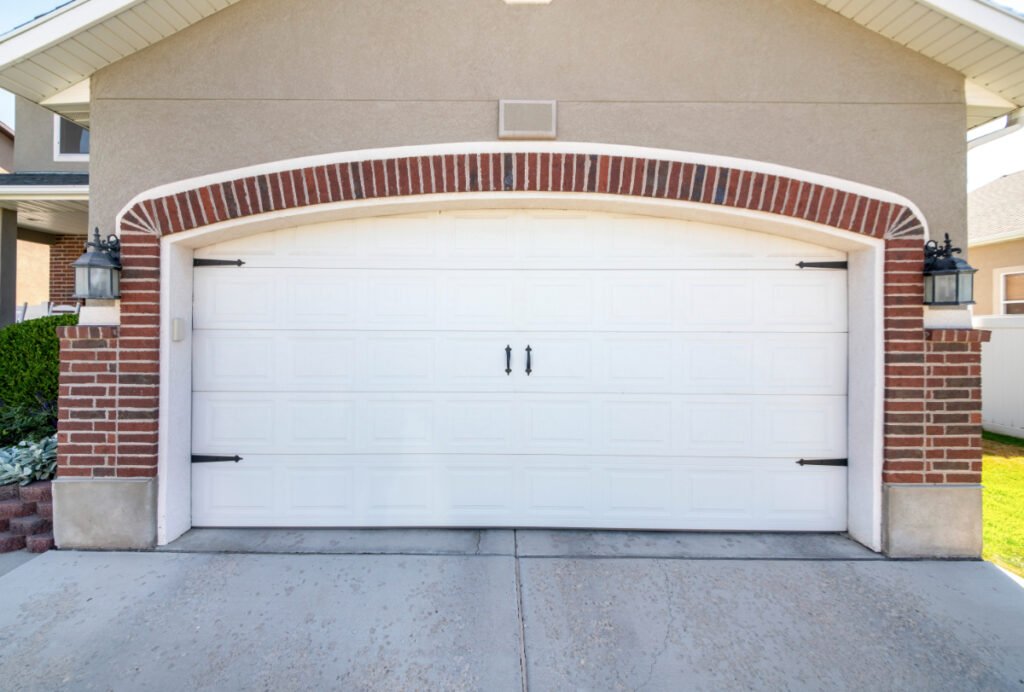
What Is It: Side-hinged doors are like regular barn doors that swing open and close from a fixed hinge on one side of the wall.
A side-hinged garage door is a simple, manually operated door with equal-sized bays and clear headroom that allows more space and a clear attic inside. It generally comes with a standard-sized installation frame but can be customized and automated with unique conversion arms.
| Average Cost | $500 – 1000 |
| Average Lifespan | 15 – 20 years |
| Prominent Materials | Wood, Steel, and Glass Reinforced Polyester |
| Average Weight | 125 – 200 lbs |
Pros:
- Opens from the middle and allows space for wall storage
- Adapt well to both smaller and bigger garages
- Minimal noise during garage door operations
Cons:
- Are difficult and costly to automate
- Are not as secure as roller doors
- Do not offer a clear drive-way
- Cannot be used for 4-car or commercial garages
Use 50-70 mm steel frames or pick good-quality Cedar wood frames to provide more support and sturdiness to the side hinges.
5. Tilt-up or Canopy Garage Door
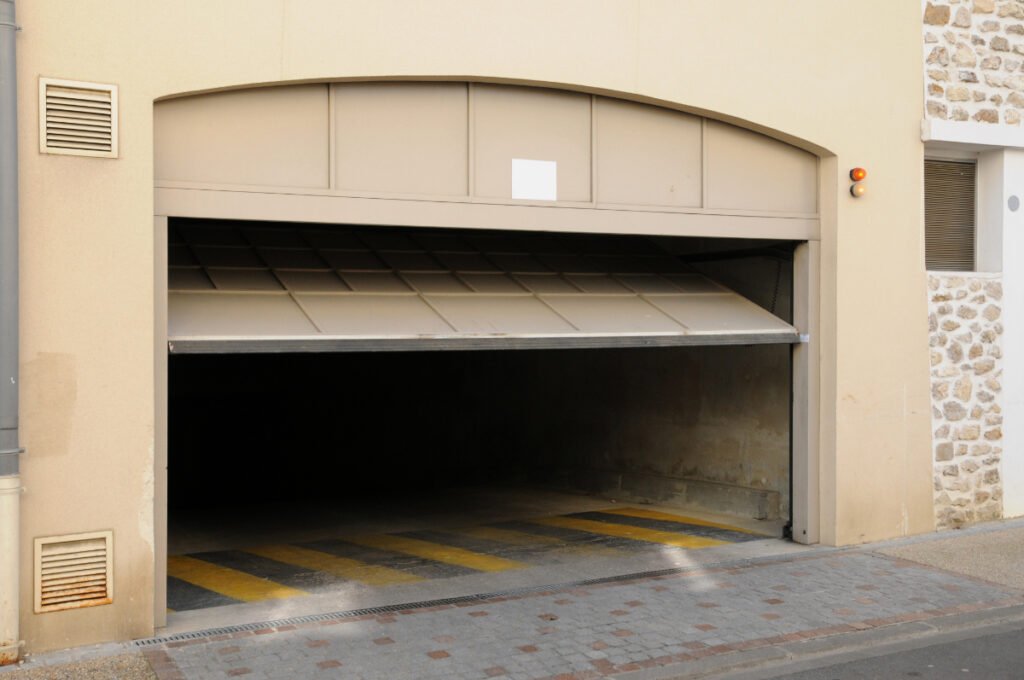
What Is It: A canopy garage door is a slender, one-piece garage door with small pivoting hinges that tilt it up and form a canopy in front of the garage when fully open.
Canopy doors are affordable and stylish, available in various materials and designs that suit both traditional and modern settings. They can be manually operated or automated as per convenience and use heavy-duty torsion springs to prevent mishaps.
However, they do not offer a clear driveway, and about ⅓rd of the door protrudes from the plane and might dash your cars.
| Average Cost | $600 – 2000 |
| Average Lifespan | 15 – 30 years |
| Prominent Materials | Aluminum, Galvanized Steel, Wood |
| Average Weight | 120 – 130 lbs |
Pros:
- Easy to install and offers maximum drive-through width
- Easy to maintain
- Fewer Parts and Lesser Friction
Cons:
- Difficult to insulate and seal
- Expensive to automate
- Takes up some space at the top of the garage
Wood canopy doors might split after 2-3 years due to sunlight and harsh weather conditions. Hence, fill them up using a good-quality wood filler and lubricate them with oil or WD-40 to retain their shine.
6. Retractable Garage Doors
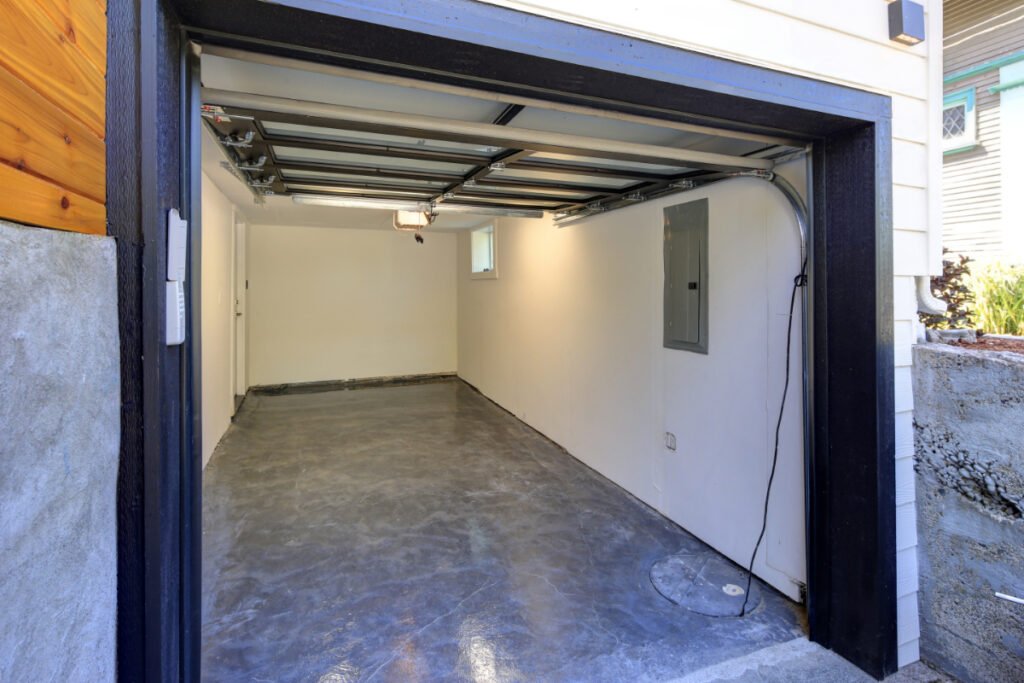
What Is It: Retractable garage doors are single-panel, tilting doors that lift and tilt inside the garage and do not extend beyond the frame piers in an open position.
Retractable garage doors run on horizontal tracks and operate with an electric remote that opens and closes them without any manual force. However, they take up more space inside the garage and considerably reduce your ceiling height and driveway width. Plus, they are expensive and need more maintenance and lubrication for smooth operation.
| Average Cost | $1000 – 2500 |
| Average Lifespan | 20 – 30 years |
| Prominent Materials | Aluminum, Fiberglass, Vinyl, Alloyed Steel |
| Average Weight | 150 – 200 lbs |
Pros:
- Automatic and Convenient
- Noise-free Operations
- Provide an unobstructed Drive-way
Cons:
- Cannot hold thicker insulation like Spray foam, Rigid foam or Wood batt
- Has a complex construction and complicated installation
- Requires more space inside the garage
Never use petroleum or oil-based sprays to lubricate your retractable doors as they might attract dust and hamper the door operation. Instead, use dry-silicone or white grease sprays to lubricate these.
Comparing Popular Garage Door Mechanisms
| Parameter | Sectional | Roller | Slide-to-Side | Side-Hinged | Canopy | Retractable |
| Weight | Medium | High | Light | High | Light | High |
| Weather Resistant | High | High | Low | Low | High | Moderate |
| Cost | Moderate | High | Low | Low | Medium | High |
| Lifespan | Low | High | Low | Low | High | High |
| Corrosion Resistant | Yes | Yes | No | No | No | No |
| Security | High | High | Medium | Low | High | High |
| Ease of Use | Easy | Easy | Moderate | Moderate | Easy | Moderate |
Types of Doors Based On Garage Door Style
Garage doors broadly impact the style statement of your home and boost its curb appeal. And they come in various styles, shapes, designs, and finishes that adapt to traditional or modern settings effortlessly.
So, let’s pick the right garage door for timeless decor and high visual appeal.
7. Paneled Doors
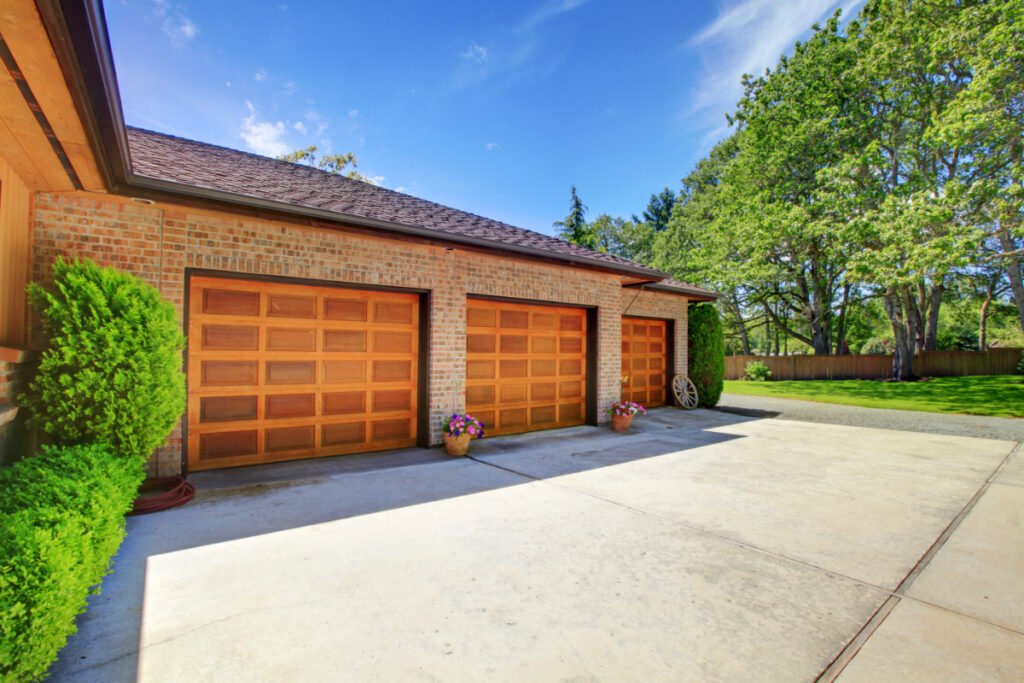
Design Style: Traditional or Classical with wood and Modern and Industrial with Metals and Vinyl.
Sturdy, heavy, and thick, Paneled doors are the right tap for single-car or 2-car garage doors. These ooze a timeless look for your garage and offer thicker insulation that reduces your energy costs.
Plus, they can be polished and reglazed for a chic, modern look and typically require less maintenance than any other garage door.
Moreover, you can use stained Rosewood, Ivory Coast Teak, or White Ash wood panels to add a tone of luxury and elegance to your door, or just pick Mild steel or Aluminum panels for a shiny, minimalist appearance. And, don’t forget to add contrasting color trims and hardware to make them stand out more.
| Average Cost | $1000 – 2000 |
| Average Lifespan | 25 – 30 years |
| Prominent Materials | Aluminum, Fiberglass, Vinyl, Alloyed Steel |
| Average Weight | 150 – 225 lbs |
Pros:
- Hard, Strong, and Elegant
- Can be customized to any Shape and Size of choice
- Weatherproof and Requires Less Maintenance
- Provides good insulation against vibrations and sound
Cons:
- Bit expensive
- It attracts dust and needs regular wiping for a dust-free surface
Regularly polish paneled doors with Tung oil, tea-tree oil, and lemon pledge, or simply varnish them for a glossy surface and smooth finish.
8. Carriage Wood Doors
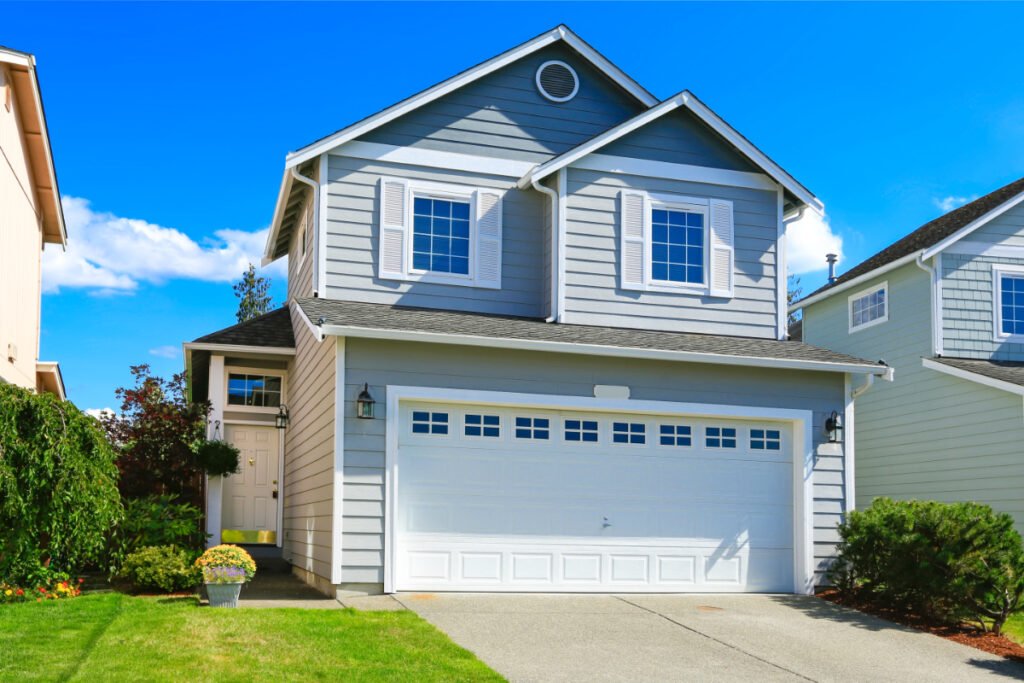
Design Style: Traditional, Classical, Vintage, and Farmhouse.
Carriage style ooze a maximal yet traditional aura with doubly-fitted windows at the top of the shutter and a rustic, wooden surface that replicates the countryside.
These garage doors have equally divided bays that swing out when you open the door and allow more floor space instead. And these are strong, sturdy, thick, and last a lifetime with minimal maintenance.
| Average Cost | $1500 – 1700 |
| Average Lifespan | 25 – 35 years |
| Prominent Materials | Wood, Faux Wood, and Wood Composite |
| Average Weight | 200 – 350 lbs |
Pros:
- Do not take up space above a garage door and Gives a clear ceiling
- Allow more natural light into the space
- Sturdy and challenging to break during burglary
Cons:
- Swing out, and May obstruct the Driveway
- Expensive to Automate
Use a heavy-duty chain-drive door opener with a durable swing gate motor to automate heavier wooden carriage doors.
9. French-Style Doors
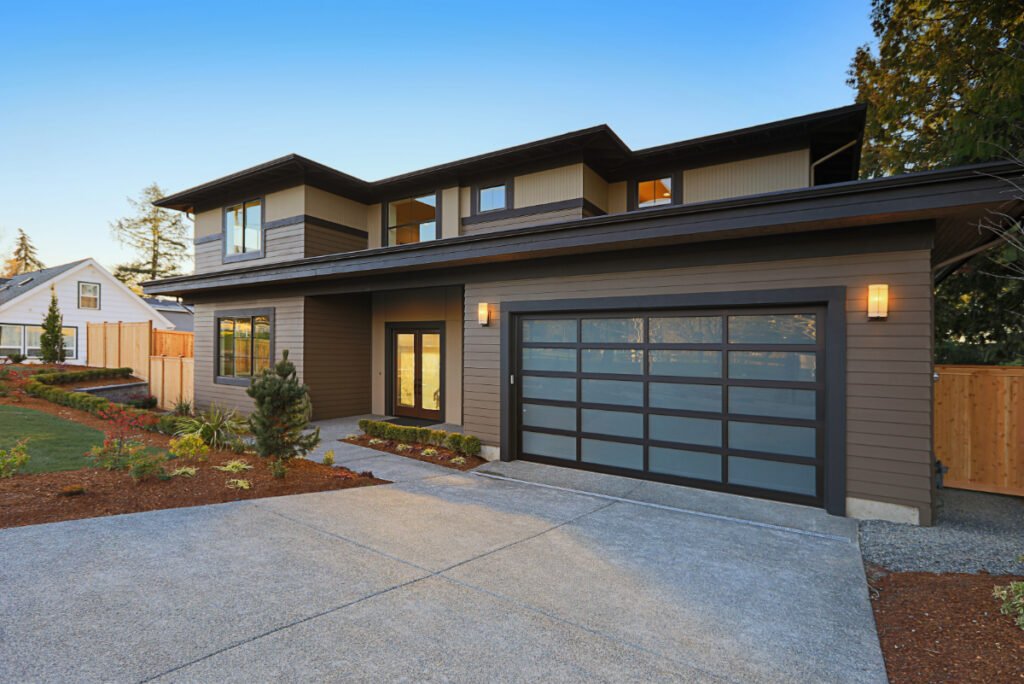
Design Style: French-Countrystyle, Minimal, Eclectic, Industrial or Scandinavian.
This garage door type is fully glazed, seamless, and minimal. Its concealed frames and hardware not only add a high-end, ultra-modern appeal to everyday homes but also allow more natural light and air circulation within the garage.
However, it does not withstand heavy noise, vibrations, and sunlight and might dent or crack easily.
| Average Cost | $2000 – 5000 |
| Average Lifespan | 10 – 12 years |
| Prominent Materials | Vinyl, Fiberglass, and Clad wood |
| Average Weight | 250 – 300 lbs |
Pros:
- Make the garage look spacious and brighter
- Can be used for residential as well as commercial garage door
- Aesthetically pleasing and Easily customizable
Cons:
- Need more space to open and close
- Quite expensive, but do not last long
- Do not adapt to different design styles
- Do not provide proper insulation and aren’t energy-efficient
Vacuum the rust flakes, chips, and divots from the door’s tracks and clean those with a good rust remover or inhibitor spray for noise-free operations.
10. Contemporary Doors
Design Style: Contemporary, Modern, Minimalism, Prairie, and Zen.
A contemporary garage door is polished and less ornate. Generally, it has clean, sleek lines and a solid, uniform door board that curls and coils onto a rolling drum when opened.
Moreover, it comes in various colors and finishes and may have some box windows at the top to break its monotony. And, it makes your home look high-end and luxurious instantly!
| Average Cost | $4000 – 7500 |
| Average Lifespan | 15 – 30 years |
| Prominent Materials | Alloyed Steel, Aluminum or Galvanized Steel |
| Average Weight | 130 – 200 lbs |
Pros:
- Lightweight and Easy to Use
- Versatile and Matches any entry door style
- Cannot be operated without passwords and enhance security
- Allows you to control the opening speed
Cons:
- Expensive and High Initial Investment
- Need high-power batteries to run smoothly
- Can corrode due to continuous moisture exposure
Add a weather strip to protect the shutter from water and moisture.
11. Craftsman Garage Doors
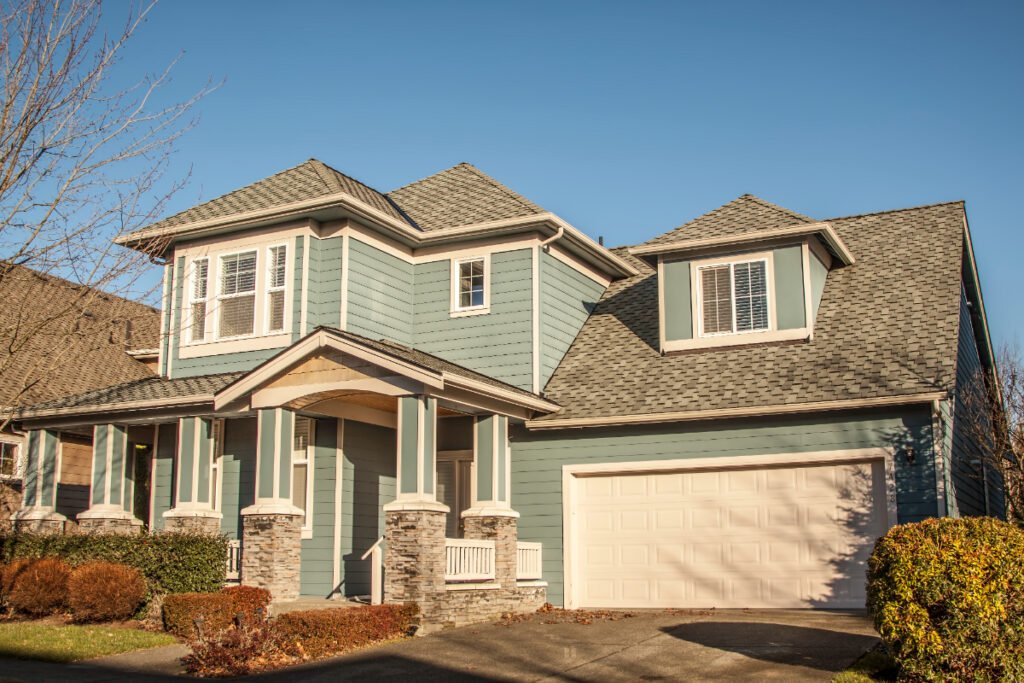
Design Style: Ranch, Craftsman, Cape Cod, and Classical.
Craftsman garage doors are simple, with straight lines and structured molding, and have vertically-recessed wooden or metal panels that add a vintage-style ambiance to the overall space.
Moreover, they might have square or rectangular vents at the top and often have high insulation that protects the garage from vibrations, snow, and sound.
| Average Cost | $1000 – 2500 |
| Average Lifespan | 15 – 30 years |
| Prominent Materials | Wood, Vinyl or Galvanized Steel |
| Average Weight | 150 – 200 lbs |
Pros:
- Simple, Stylish and Luxurious Look
- More Sustainable and Low Carbon Footprint
- Easily customizable and fits any aesthetic
- Increases the home’s Resale Value
Cons:
- Staining or Painting is necessary for more durability
- Might not be cost-efficient due to high maintenance
Use wooden Craftsman doors with stone or wood facades for a Ranch-style, transitional look, or pick metal doors and concrete facades for a lovely mid-century modern aesthetic.
12. Mission Garage Doors
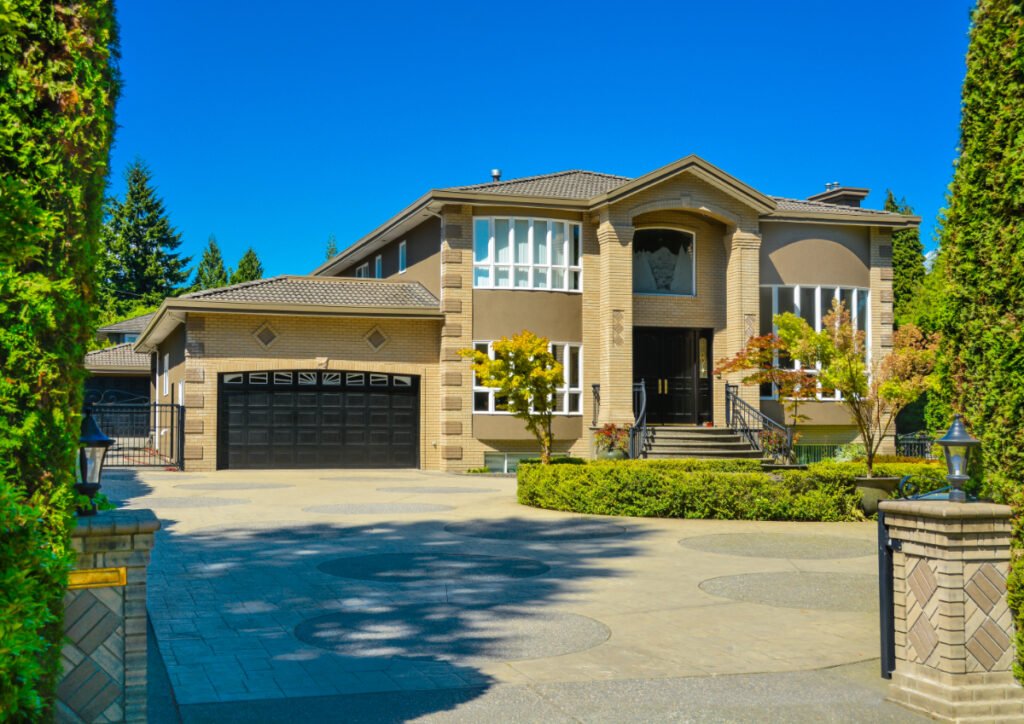
Design Style: Mediterranean, Mission, Spanish, and Colonial.
Mission garage doors are slightly rustic, maximal, and ornamented. They have exposed hardware, nail heads, hinges, and handles that give a touch of industrial style but exude a villa-like ambiance.
Plus, these have equally divided bays and grooved panels with arched windows that allow more light and ventilation.
| Average Cost | $1800 – 2000 |
| Average Lifespan | 20 – 30 years |
| Prominent Materials | Wood, Faux Wood or Galvanized Steel |
| Average Weight | 150 – 200 lbs |
Pros:
- Durable and doesn’t need much garage door repair
- Easy Installation and Access
- Affordable
- Resists Corrosion and Rust
- Allows more natural light into the space
Cons:
- Might malfunction with any Automatic garage door opener
- Do not offer a clear driveway
Brush off all the dust and grime using warm water and a mild detergent and coat these doors with a thin coat of car wax for a shiny, glazed look.
13. Modern Garage Doors
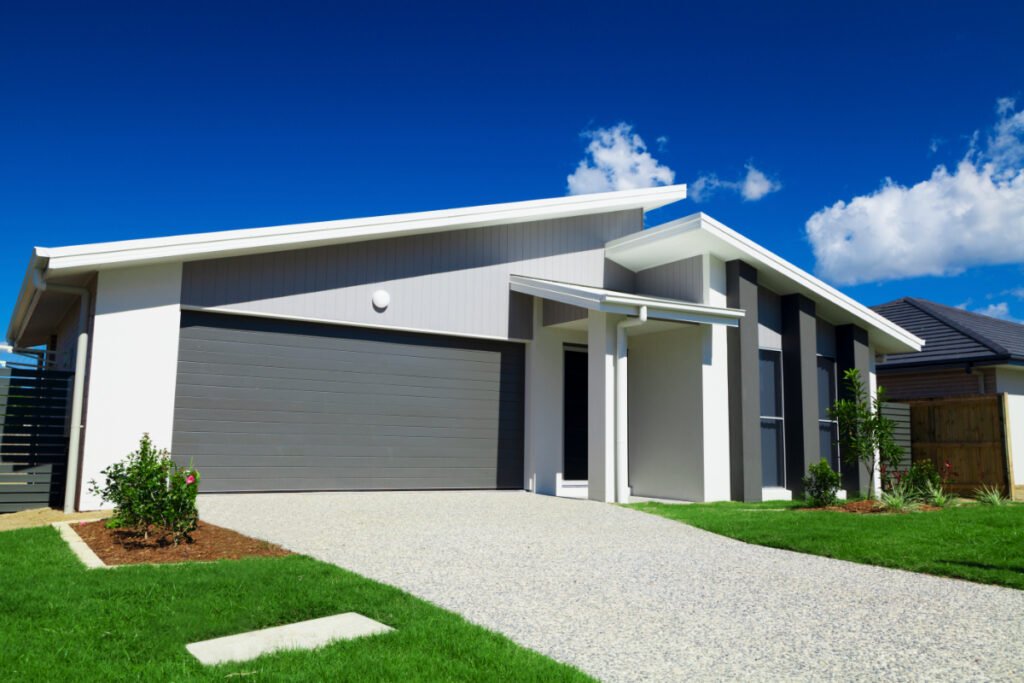
Design Style: Modern, Japandi, Bohemian, Scandinavian, and Industrial.
Modern garage doors are more contextual and mix and match the clear lines of Japanese shoji screens and vernacular doors with the sleek textures of metal, steel, wood, and glass.
These are automated, lightweight, minimal, and offer a luxurious, high-end look to any space. Moreover, they are customizable, and you can redesign or replace them easily.
| Average Cost | $ 3000 – 5000 |
| Average Lifespan | 15 – 30 years |
| Prominent Materials | Wood, Steel, Aluminum, Glass, Vinyl |
| Average Weight | 130 – 150 lbs |
Pros:
- Lightweight and Easy to Install
- Provide adequate lighting and No need to Paint
- Durable; They do not rust easily
- Look Ethnic and Refined
Cons:
- High initial cost
- Poses minor security risks and requires a sturdy garage door lock
- Cannot hold heavy insulation and foam panels
Periodically check for any loosened cables, extension springs, pulleys or hinges and get them replaced by a professional technician as soon as possible.
Comparing Popular Garage Door Styles
| Parameter | Paneled | Carriage | French | Contemporary | Craftsman | Mission | Modern |
| Style | Transitional | Vintage | FrenchCountry | Contemporary | Ranch | Mission | Japandi |
| Weight | High | High | High | Light | Moderate | Moderate | Light |
| Maintenance | Low | Low | High | Low | High | Low | Low |
| Ease of Customization | High | Moderate | High | Low | High | Low | High |
| Durability | Moderate | High | Low | High | Moderate | High | Moderate |
Types of Doors Based On Garage Door Material
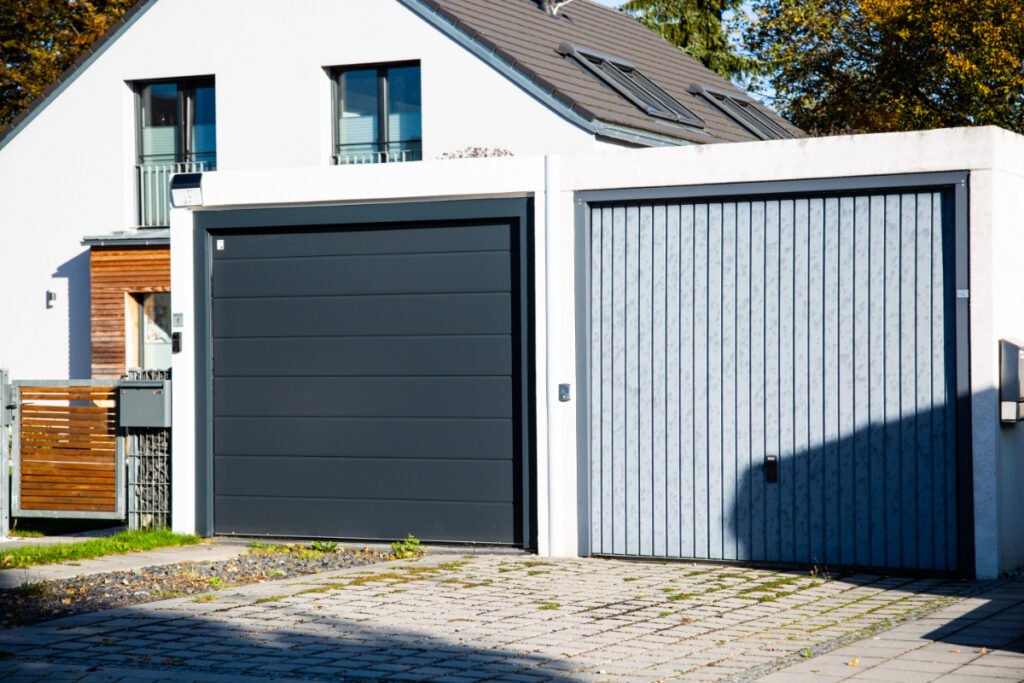
Replacing a garage door now and then is really cumbersome. So, when buying a new garage door, shouldn’t you be sure of the durability and materials? Good-quality materials not only enhance the lifespan of your door but keep it free from rust and pests.
Here, let’s check out some of the popular materials for a garage door.
14. Steel Garage Doors
Steel doors are durable, energy-efficient, and customizable but need to be coated with anti-rust solutions and silicone lubricants to last longer. Plus, they are inexpensive and lightweight and come with a higher warranty of about five years.
15. Aluminum Doors
An aluminum garage door is lightweight, affordable, moisture-resistant, and the best material for manually operated doors. Plus, it is a naturally insulated door and keeps your garage warm and noise-free.
16. Vinyl Doors
Vinyl garage doors are ornate, lightweight, and easy to maintain but deteriorate and warm when exposed to extreme temperatures. But they are very versatile and adapt easily to any automation system.
17. Wood Composite Doors
Wood composite doors are lightweight, maintenance, and noise-free and have a natural wood-like appearance and texture. However, these cannot be customized and have a limited palette of designs.
18. Fiberglass Garage Doors
Fiberglass garage doors are lightweight and noise-free but are poor insulators and do not remain warm. Moreover, these are highly brittle and chip or crack when exposed to cold weather. But, you can use these for a detached garage or a manually-operated residential garage door.
19. Glass Doors
Glass doors are contemporary, clean, and minimal. They allow more natural light in your garage and retain heat efficiently. However, they are transparent and crack when exposed to hot weather and winds. But, you can always add glass furnishing on top of a steel door to have a shiny, polished door without compromising strength.
20. Wood Garage Doors
A wood door is traditional, versatile, and energy-efficient. And it is thick, sturdy, and lasts a lifetime. However, wood doors are expensive and warp, bend or rot quickly when exposed to moisture. Plus, they require heavy maintenance and upkeep to last longer.
Garage door materials are indeed a crucial factor for sturdy, lightweight, and durable doors, And, you can learn more about the pros, cons, and costs for different garage door materials here.
Things to Consider When Buying a New Garage Door
Garage doors come in different sizes, materials, finishes, and panels. And while it’s confusing to pick one from the various options available in the market, we have some handy tips and tricks to make your job easier.
- Decor Style: Always choose a door that blends with the style and architecture of your home. For instance, get an overhead or rolling shutter for your modern house while picking traditional mission shutters for an ethnic setting.
- Durability: Sturdier wooden or craftsman doors last a lifetime and won’t incur significant maintenance issues. On the other hand, a steel garage door is prone to rust and requires some anti-rust treatment from time to time.
- Compatibility with Openers: If you want your overhead or rolling doors to be compatible with automatic garage door openers, choose them.
- Cost: Usually, wood doors have a higher upfront cost, about $4000-5000, but they are the most cost-efficient option in the long run. In contrast, fiberglass garage doors are inexpensive but might warp or crack sooner.
- Maintenance: Get steel rolling shutters for low maintenance. All they need is lubrication and anti-rust treatment, and you are done! In contrast, traditional doors require dusting, groove-cleaning, and lubrication which can be time-consuming.
- Energy efficiency: Pick thicker wood, steel, or glass doors for a warmer garage without additional air conditioning. You can always add additional garage door insulation to make them even more comfortable and convenient.
What Type of Garage Door is Cheapest?
Roller doors are usually the most affordable garage doors, starting at $600-700, including the frame. And, you can always buy smaller, ready-to-ship doors to further save on costs and insulation.
How Often Should You Change Your Garage Door?
You should change your wooden garage doors every 30 – 35 years or when they chip weather and discolor. Replace your steel doors every 20 – 25 years or when they show signs of rusting, denting, or buckling.
What is the Most Popular Garage Door?
Sectional doors are the most popular garage doors available in the market and offer a classic, timeless aesthetic with their panels and rectangular windows. Moreover, these can be customized to single or double bays and are easy to use.
What Type Of Garage Door Is Most Durable?
Wooden Paneled doors are the most durable and long-lasting doors, provided that you maintain them properly and paint them from time to time. Similarly, retractable steel doors are pretty efficient and will easily last for about 25 – 30 years without damage.
Garage doors are the most prominent facade feature in any home and extensively impact the garage’s decor, operations, and insulation. While manually operated doors are perfect for larger patios and a traditional ambiance, you can get automated ones for elderly homeowners or minimalist homes.
And you can make them even more durable with lightweight garage door materials like fiberglass, steel, or wood composite. All you need to do is pick the type of door! Once done, don’t forget to pick the best garage door bottom seals for your door!

